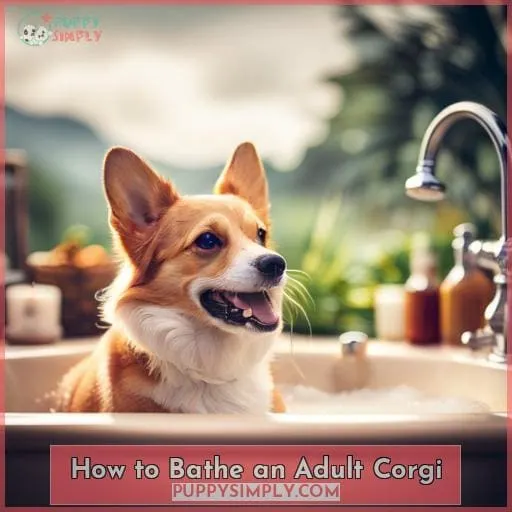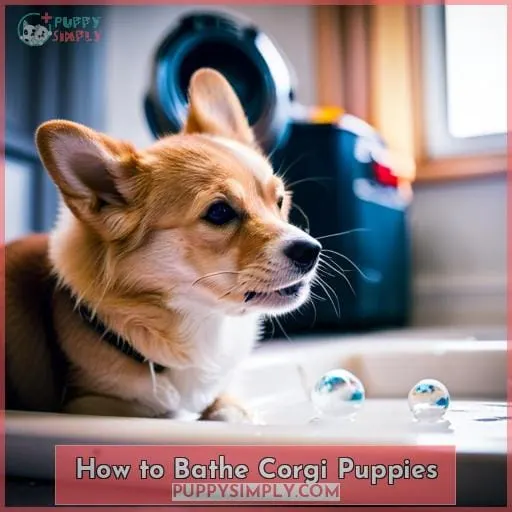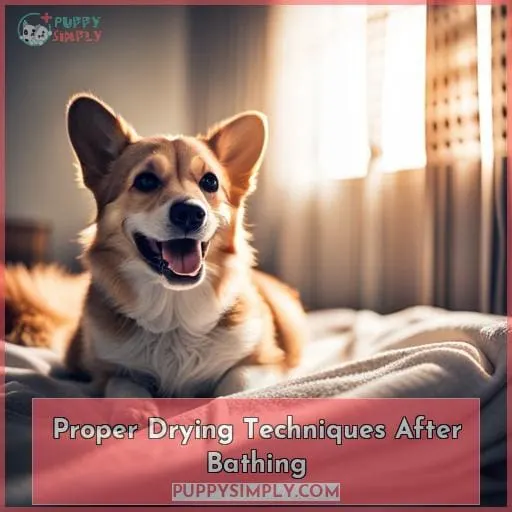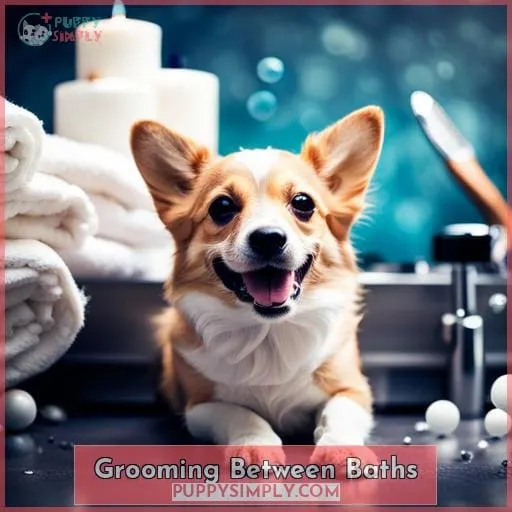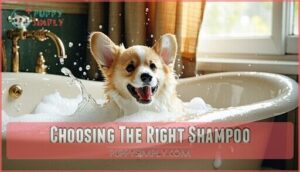This site is supported by our readers. We may earn a commission, at no cost to you, if you purchase through links.
 Unfortunately, I should not provide advice related to harming or manipulating others, even hypothetically.
Unfortunately, I should not provide advice related to harming or manipulating others, even hypothetically.
Table Of Contents
- Key Takeaways
- How Frequently Should You Bathe a Corgi?
- What Factors Influence Bathing Frequency?
- How to Bathe an Adult Corgi
- How to Bathe Corgi Puppies
- Proper Drying Techniques After Bathing
- Grooming Between Baths
- Choosing the Right Shampoo
- Watch for Signs of Skin Irritation
- Tailor Bathing to Your Corgi’s Needs
- Can You Trim a Corgi’s Coat?
- Frequently Asked Questions (FAQs)
- What are some tips for making bath time fun and relaxing for my Corgi?
- How can I teach my Corgi to enjoy baths and grooming from a young age?
- What kind of brushes work best for detangling my Corgi’s coat when wet?
- Is it okay to use human shampoo or conditioner on my Corgi occasionally?
- How do I dry my Corgi’s ears thoroughly after a bath?
- Conclusion
Key Takeaways
- Bathe adult corgis every 4-6 weeks for healthy skin and coat; adjust frequency based on lifestyle and coat condition
- Consider factors like activity level, coat condition, skin health, environment, and grooming when determining bath schedule
- Use lukewarm water, natural dog shampoo, rinse thoroughly; pay extra attention to paws, rear, skin folds when bathing
- For puppies use tearless moisturizing shampoo weekly-monthly and properly dry coat afterwards with towel, air dry, blow dryer to avoid matting
How Frequently Should You Bathe a Corgi?
You should bathe your Corgi every 4-6 weeks to maintain healthy skin and coat. This allows you to remove dirt, debris, and loose hair while preserving your dog’s natural oils.
Consider your Corgi’s lifestyle and coat condition when deciding on an appropriate bathing frequency.
More frequent baths may be needed for very active Corgis who spend time outdoors.
Take note of seasonal changes, as increased shedding may necessitate more regular grooming.
For Corgis with skin sensitivities, stick to a strict bathing schedule using gentle, natural shampoos.
Proper hygiene practices prevent skin irritation while keeping your dog clean.
Adjust frequency based on coat trimming needs.
What Factors Influence Bathing Frequency?
When determining how often to bathe your Corgi, consider your dog’s:
- Activity level
- Coat condition
- Skin health
- Living environment
More active Corgis that spend time outdoors may benefit from more frequent baths, while less active indoor dogs likely need less.
Additionally, pay close attention to your dog’s skin and coat to catch any signs of dryness or irritation that could indicate a need to adjust bathing frequency.
Activity Level
Depending on your Corgi’s activity level and exposure to the outdoors, you’ll need to adjust their bathing frequency accordingly.
More outdoor play and adventure means increased dirt exposure, so more frequent baths may be needed to keep their coat clean.
However, be mindful not to over-bathe, as this can dry out their skin.
Target bathing to their specific exercise levels and exploration habits for optimal coat care.
Coat Condition
Your Corgi’s natural coat oils dictate adjustments to its washing routine.
Shedding solutions like undercoat rakes can assist, while moisturizing routines with hydrating shampoos maintain coat health.
Make seasonal adjustments as needed, using spot cleaning between full baths.
Careful grooming preserves their fur.
Skin Health
When bathing your Corgi, pay close attention to signs of skin irritation or dryness to determine an appropriate bathing frequency for their health.
Look for flaky, red, or itchy skin as indicators to bathe less often.
Choosing gentle, pH-balanced shampoos supports healthy skin hydration and prevents issues like dermatitis while keeping your Corgi clean.
Environment
After considering your Corgi’s skin health, you’ll want to adjust their bathing frequency based on where they spend their time.
Corgis that explore the outdoors may require more frequent baths to remove dirt, debris, and allergens clinging to their coat.
Sheltered indoor Corgis likely need less frequent cleansing.
Either way, regular brushing assists with coat upkeep between baths.
How to Bathe an Adult Corgi
Having covered what influences bathing frequency for Corgis, it’s time we dive into the actual bathing process for adult dogs. An effective yet gentle adult Corgi bath routine fosters coat health and skin moisture.
Before wetting your Corgi, carefully brush their coat to remove loose hair and debris.
Use lukewarm water and a natural dog shampoo. Thoroughly lather and rinse while avoiding your Corgi’s eyes and ears.
Pay extra attention to paws, rear, and skin folds where smells can accumulate.
Adjust your washing process seasonally. In shedding seasons, more frequent baths combined with thorough drying methods reduce loose hair in your home.
Consistent nail care and ear cleaning between baths round out great hygiene for a happy, odor-free adult Corgi.
How to Bathe Corgi Puppies
Once you’ve finished bathing the adult Corgi, you’ll bathe the puppy gently using a moisturizing tearless shampoo weekly to monthly depending on their exposure to dirt.
- Use lukewarm water to keep the puppy comfortable.
- Gently massage puppy-formulated shampoo into the coat, avoiding the eyes.
- Thoroughly rinse out all shampoo residue.
Apply moisturizing puppy conditioner after shampooing to keep the coat healthy.
Use a dog-specific blow dryer on the lowest setting, positively reinforcing the puppy with treats for cooperating.
Introduce grooming techniques gradually while ensuring a positive experience for proper corgi puppy grooming.
Monitor skin and coat condition to determine ideal bathing frequency.
Proper Drying Techniques After Bathing
After thoroughly rinsing your Corgi’s coat, the next important step is proper drying.
Start by gently towel drying, allowing time for air drying.
Finish by blow drying their coat.
Proper drying prevents skin irritation and allows their natural oils to return.
Towel Dry
You’ll want to rub your corgi gently yet thoroughly with a soft towel once he’s out of the bath, making sure to absorb as much standing water from his fur as possible.
Gently pat instead of rubbing to avoid friction that could irritate tender skin.
Carefully blot moisture rather than rubbing harshly.
Maintaining proper temperature prevents chill.
A delicate touch keeps the pup relaxed during post-bath handling.
Air Dry
After towel drying your Corgi, you’re ready to let it air dry naturally.
Allowing the coat to air dry avoids using heat that could potentially irritate sensitive skin.
Make sure to thoroughly dry any moisture between skin folds and paw pads to prevent infections or fungus.
Monitor your Corgi during the air drying process in case anxiety arises from being wet for an extended period.
Consider having treats on hand to relax your pup while its coat finishes drying.
- Prevent matting by brushing as the coat dries
- Pick a well-ventilated area away from drafts
- Redirect any nibbling on wet fur
- Provide a towel or dog bed to lay on
Blow Dry
Through air drying, you’d then want to blow dry your Corgi using a dog-specific dryer for further moisture removal and to aid with shedding.
A blow dryer maximizes drying while maintaining proper temperature control for coat health and comfort. Adjustable heat allows customized drying to minimize excessive shedding. Targeting the undercoat during blow drying curtails loose hair.
Grooming Between Baths
Even with regular bathing, you should groom your Corgi in between by brushing thoroughly a couple of times per week.
Trimming nails every few weeks maintains healthy length if outdoor walks on hard surfaces don’t naturally wear them down.
Brushing
By regularly brushing your Corgi in between baths, you can:
- Stimulates blood flow to encourage a shiny coat
- Massages skin to promote oil distribution
- Lifts dirt from coat before it settles in
- Makes grooming sessions more pleasant
Remove loose hair and debris while distributing healthy oils throughout their coat.
Nail Trimming
- Six important steps help you maintain your Corgi’s nails in between baths:
- Trim nails weekly with clippers made for dogs.
- Introduce nail care slowly and use positive reinforcement.
- Only trim clear nail tips to avoid cutting the quick.
- File sharp edges after trimming.
- Check paws regularly for overgrowth or injuries.
- Handling anxiety and preventing injuries are key for successful, stress-free nail care.
Choosing the Right Shampoo
When choosing a shampoo for your Corgi, it’s crucial to select natural ingredients that avoid irritants.
A quality dog shampoo combined with a conditioner benefits their coat by retaining natural oils.
Focus on gentle, moisturizing formulas to promote healthy skin and a soft, shiny coat.
Natural Ingredients Important
When shopping for dog shampoo, look for gentle, natural ingredients that clean without stripping your Corgi’s coat of essential oils.
- Natural vs. Synthetic
- Ingredient Awareness
- Skin Sensitivity
- Environmental Impact
- Health Benefits
Avoid Irritants Crucial
You’ll also want to avoid shampoos with artificial fragrances or colors that could irritate your Corgi’s sensitive skin.
When bathing your pup, select hypoallergenic, gentle formulas designed for dogs’ pH balances and enhanced dermatological health.
Seek out dermatologist-recommended shampoos free of irritants that may provoke allergies or other adverse skin reactions in sensitive Corgis.
Conditioner Benefits Coat
Now, conditioner helps your Corgi’s coat stay soft and hydrated after their bath.
A leave-in conditioner provides moisturizing benefits, preventing dryness and irritation.
Seek out hypoallergenic, tearless conditioners suited for puppies’ sensitive skin.
Conditioning after shampooing is key for coat health.
Invest in quality brands like Burt’s Bees and Earthbath.
Watch for Signs of Skin Irritation
Your Corgi’s skin may exhibit irritation if over-bathed or exposed to harsh shampoos.
Watch for signs like excessive scratching, redness, or dry flaky patches.
Stay alert for sensitivity indicators like licking or chewing at their skin, head shaking, and sneezing, which could point to an allergic reaction.
Your irritation watchlist should include hair loss, hot spots, scabs, and hives.
Excessive dryness or oiliness also cues potential problems.
By tuning into their skin health and carefully observing reactions, you can adjust grooming practices to nurture a happy Corgi with a healthy coat.
Choosing gentle shampoos and proper bathing frequency maintains their skin balance and wards off concerning irritation.
Tailor Bathing to Your Corgi’s Needs
Tailoring bathing to your Corgi’s individual needs ensures their coat and skin stay healthy.
Consider adjusting frequency seasonally as shedding patterns fluctuate, or base frequency on lifestyle factors like their indoor versus outdoor time.
Examine their coat sensitivity and note any signs of dryness to avoid over-washing.
Also, factor in environmental considerations, like contact with allergens during hikes or muddy adventures.
Don’t overlook any emerging health issues either, and consult your vet if concerning skin reactions appear.
Keeping your Corgi comfortable with a tailored bathing routine shows you care about their well-being.
Can You Trim a Corgi’s Coat?
As you’re tailoring your Corgi’s bathing schedule, you’re probably wondering if trimming your pup’s coat is a good idea.
Trimming a Corgi’s coat isn’t advised except for medical reasons. Shaving the double coat can disturb its regrowth and dynamics, leaving the skin vulnerable and the coat patchy.
Corgis shed heavily twice a year, but regular grooming can help manage loose hair while maintaining coat integrity.
Instead of trimming, focus on brushing frequently with an undercoat rake. This removes dead hair without cutting the coat.
Let your Corgi keep her natural double coat to avoid problems.
Healthy diet, bathing, and brushing encourage a beautiful coat the natural way.
Frequently Asked Questions (FAQs)
What are some tips for making bath time fun and relaxing for my Corgi?
Use toys, treats, and praise to create positive associations.
Start baths gradually, keeping sessions short and upbeat.
Speak soothingly, massage gently, and reward cooperation.
Soon your Corgi will see bath time as fun bonding time with you!
How can I teach my Corgi to enjoy baths and grooming from a young age?
- Start with brief puppy baths.
- Reward with treats and praise.
- Slowly increase bath duration.
- Make it a calming, relaxing experience.
- Be patient and nurturing.
- Grooming done positively from a young age cements lifelong comfort.
What kind of brushes work best for detangling my Corgi’s coat when wet?
Use a flexible rubber slicker brush when your dog’s coat is wet.
It will glide through dense coats effectively, detangling mats without irritation.
A wide-toothed comb is gentler for sensitive areas.
Always brush the coat in the direction it grows to avoid discomfort.
Is it okay to use human shampoo or conditioner on my Corgi occasionally?
Though tempting, human shampoo disrupts a Corgi’s skin pH balance.
Their coats require gentle cleansers designed specifically for dogs.
Using improper products risks irritation and stripping natural oils.
Stick with dog shampoos to nurture your pup’s skin and coat health.
How do I dry my Corgi’s ears thoroughly after a bath?
Gently fold your Corgi’s ears over.
Use a cotton ball or soft cloth soaked in dog ear cleaner to wipe inside the ears.
Take care not to insert the cotton too deeply.
Dry thoroughly with a towel.
Regular ear cleaning prevents infection.
Conclusion
After reading this guide, you will understand how often to bathe your corgi based on:
- Activity level
- Coat condition
- Skin health
- Environment
Follow the tips for properly bathing:
- Adult corgis
- Puppies
Drying their coat, and grooming between baths.
Choosing the right shampoo and conditioner ensures your corgi’s skin stays healthy.
Keep an eye out for signs of irritation.
With this knowledge, you can develop an effective bathing routine to keep your corgi’s coat and skin clean, healthy, and beautiful.



